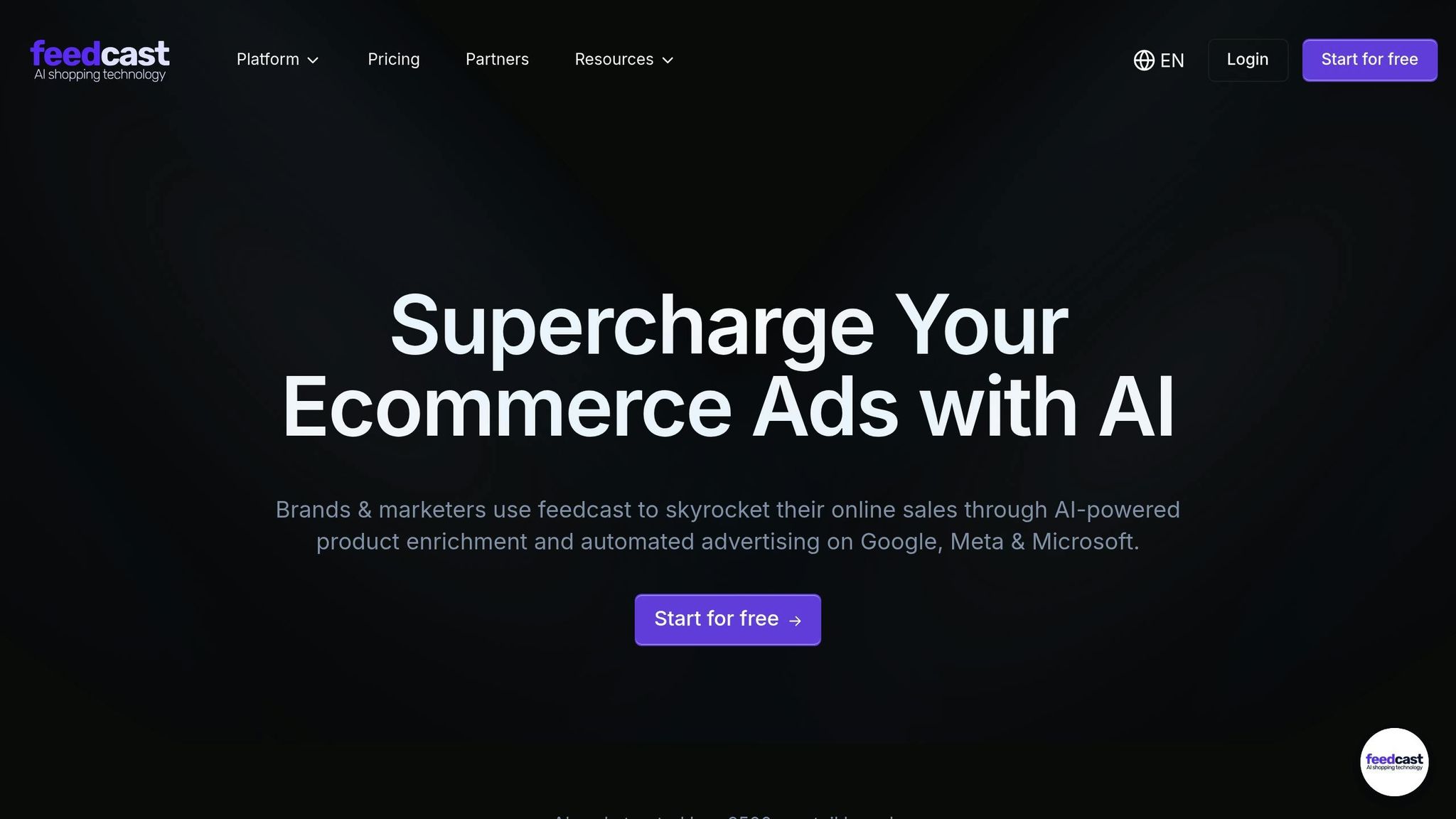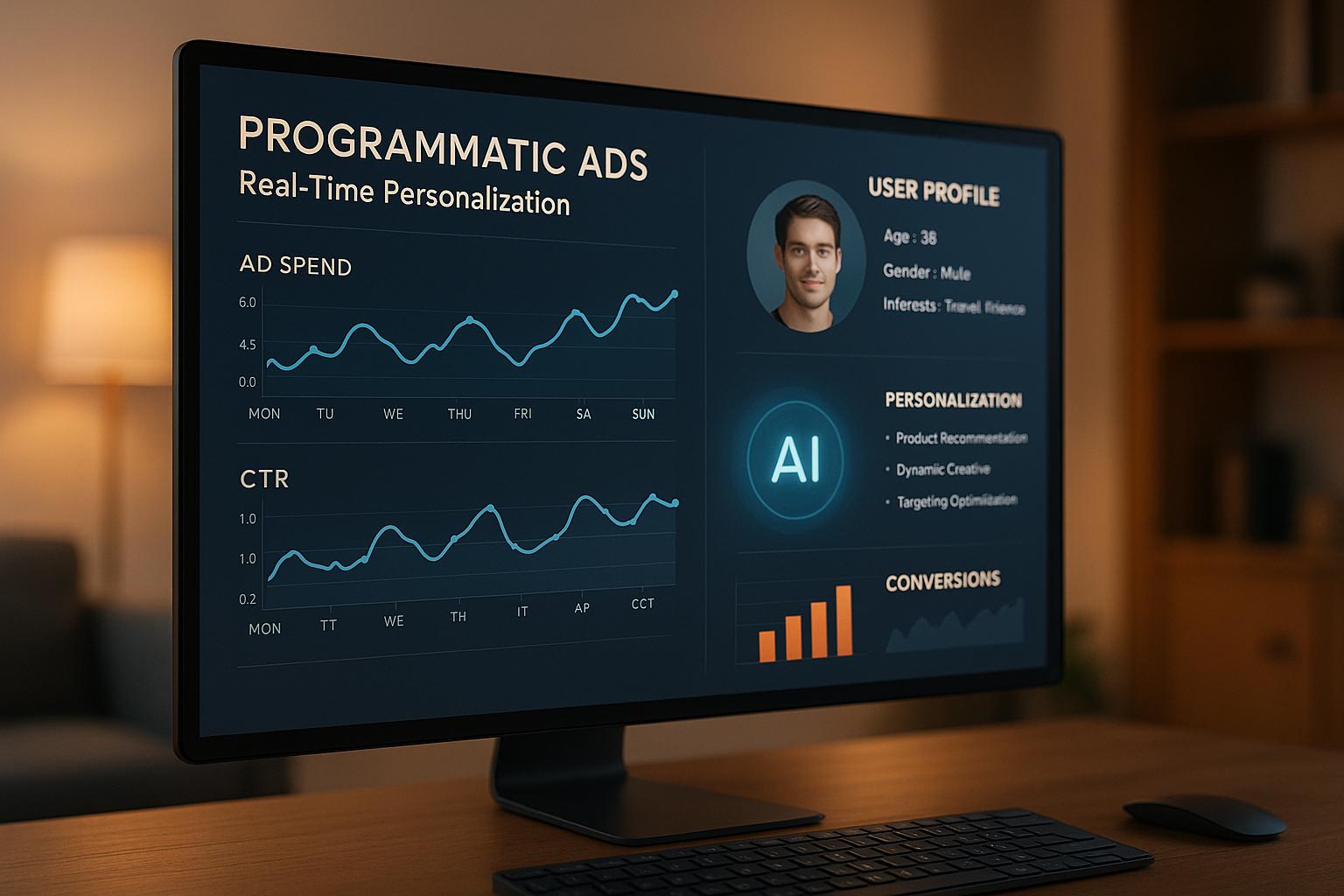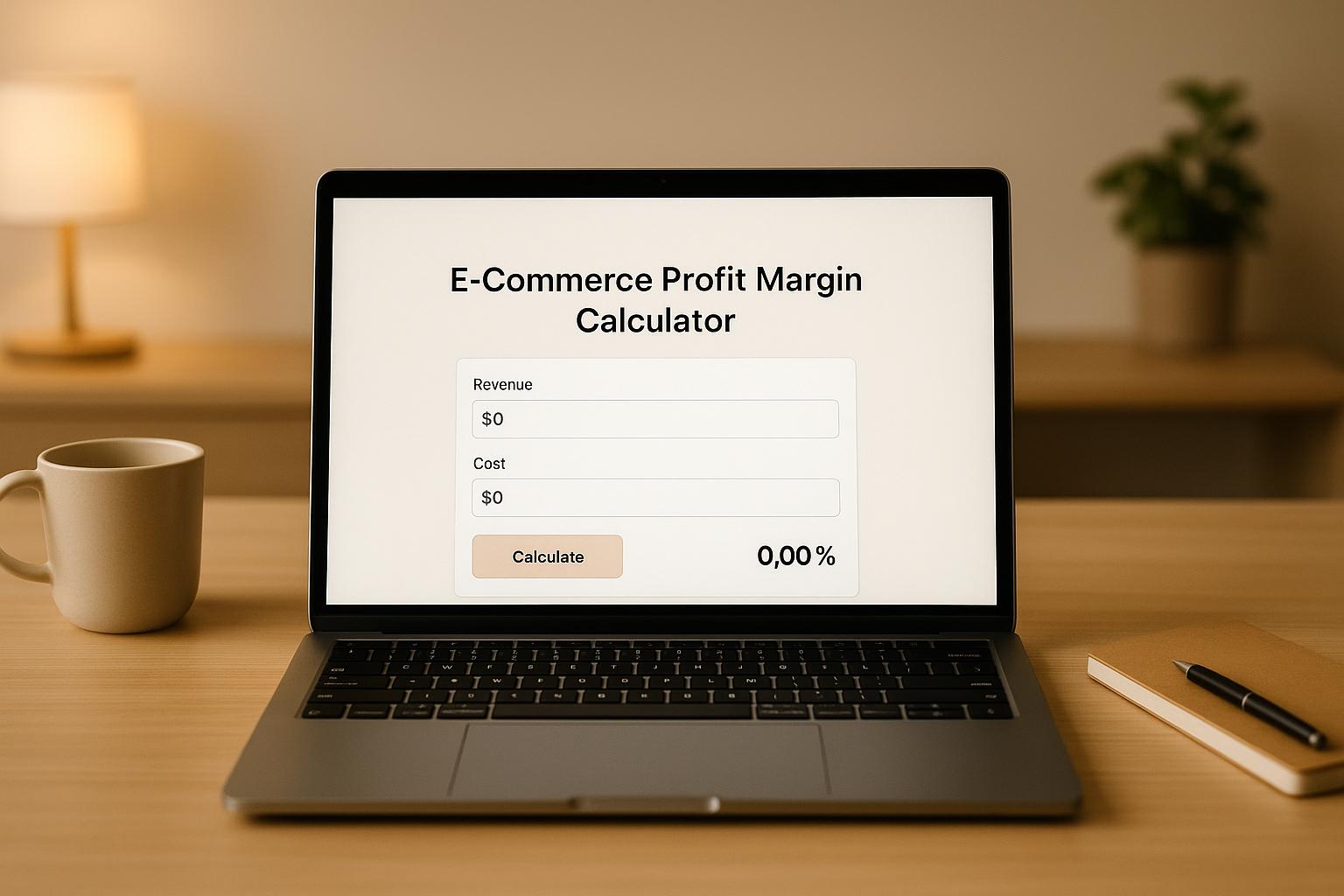How AI Powers Seasonal Ad Personalization
AI is transforming seasonal advertising by analyzing customer data, predicting shopping behaviors, and creating tailored ads for specific events like Black Friday or Cyber Monday. Unlike generic campaigns, AI ensures ads are relevant to individual shoppers, boosting engagement and conversions. Here's how it works:
- Data-Driven Targeting: AI uses purchase history, browsing habits, and demographic data to identify customer preferences.
- Real-Time Optimization: AI adjusts ad content, spend, and targeting based on live performance metrics.
- Dynamic Content Creation: Ads are personalized with custom messages, visuals, and product suggestions for different audience segments.
- Trend Predictions: AI forecasts seasonal trends and demand, helping businesses prepare inventory and strategies.
Platforms like Feedcast simplify this process by centralizing campaign management, enhancing product data, and automating ad optimization across multiple channels. This approach saves time, reduces costs, and delivers better results during high-traffic shopping periods.
Cadbury: The Art of AI and Personalization in Marketing

Key Elements of AI-Powered Seasonal Ad Personalization
AI has become a game-changer in creating tailored ad content, especially during high-stakes shopping seasons. By combining advanced data analysis with real-time optimization, AI transforms raw information into highly targeted campaigns that resonate with customers. Let’s break down the three essential components that make this possible.
Data Collection and Audience Analysis
Every effective personalized campaign starts with understanding the customer. AI collects data from various touchpoints to build detailed profiles that reveal shopping habits and preferences.
One of the most critical sources is purchase history. AI examines what customers bought, how much they spent, and the timing of their purchases. For instance, if someone consistently buys outdoor gear in spring, the system flags them as a likely target for seasonal camping promotions.
But it doesn’t stop there. AI also tracks behavioral data like website visits, email clicks, social media interactions, and ad engagements. This helps identify how customers interact with brands across different seasons - what they browse during holidays versus off-peak times.
Geographic and demographic data further refine targeting. For example, regional trends might influence the timing of ads or the tone of messaging. And the real magic happens with cross-channel integration. By pulling data from social media, email campaigns, website activity, and past purchases, AI creates a comprehensive customer view. This 360-degree profile ensures messages and products are matched to individual preferences with precision.
Dynamic Creative Optimization
Once the data is in place, AI steps in to generate and fine-tune ad content. This isn’t just about running a few A/B tests - it’s about creating countless ad variations tailored to specific audience segments.
AI automates the creation of customized ad copy, headlines, and descriptions. For instance, it might craft urgency-driven messages for last-minute shoppers or highlight budget-friendly deals for price-sensitive customers.
Visuals are also personalized. AI adjusts product images, backgrounds, and color schemes to align with seasonal themes while maintaining brand identity. A summer campaign might use bright, sunny visuals, while winter ads lean into cozy, muted tones.
What’s more, AI continuously optimizes ads in real time. It monitors performance metrics like click-through and conversion rates, reallocating budgets to the best-performing variations. For example, as Black Friday nears, the system might prioritize ads emphasizing discounts. Once the holiday passes, it can shift focus to gift cards or easy-return items.
Predictive Analytics for Seasonal Behavior
AI doesn’t just react to trends - it predicts them. By analyzing historical data, it forecasts customer behavior and seasonal patterns, giving businesses a strategic edge.
Through seasonal behavior modeling, AI identifies recurring patterns. For example, it might reveal that some shoppers begin holiday purchases in early November, while others wait until mid-December. This insight helps businesses time their promotions effectively.
AI also detects emerging trends. By analyzing search data, social media mentions, and early purchase indicators, it can spot rising product categories before they hit mainstream popularity. This allows businesses to adjust inventory and ad strategies preemptively.
In addition, AI excels at demand forecasting. It analyzes factors like weather, economic conditions, and social trends alongside historical sales data to predict which products will be in demand during specific seasonal events. Whether it’s winter coats during a cold snap or trending toys during the holidays, AI ensures businesses are ready.
How to Implement AI-Powered Seasonal Personalization
Bringing AI-powered seasonal personalization to life requires a clear plan. The process revolves around building a solid data foundation, creating dynamic audience segments, and automating ad creation. Let’s break it down.
Set Up Data Infrastructure
First things first: you need clean, reliable data flowing seamlessly between your e-commerce platform and advertising tools. Even the smartest AI tools are only as good as the data they’re working with.
Start by connecting your e-commerce platform to your advertising tools. This ensures that customer behavior and product data - like purchase history and inventory - sync automatically across your marketing channels. It’s especially critical during seasonal campaigns when inventory and pricing can change in a flash. Your AI tools must have real-time access to accurate product details, such as stock levels, updated prices, and seasonal categories, to avoid promoting out-of-stock items or outdated deals.
For example, platforms like Feedcast can unify ad accounts across Google, Meta, and Microsoft, streamlining real-time optimization. Feedcast even enhances product titles and descriptions automatically, making seasonal items easier to find. This unified setup ensures your campaigns capture the entire customer journey across touchpoints.
Once your data flows are in place, the next step is segmenting your audience effectively.
Create Dynamic Audience Segments
AI has the power to create dynamic audience segments by analyzing real-time behaviors, moving beyond basic demographics to focus on actual shopping intent and timing.
To start, gather detailed audience data - demographics, purchase history, browsing habits, and seasonal interaction patterns. This helps you uncover not just what customers buy but also when they shop and how their preferences shift during the season.
Tailor your segmentation to match your seasonal goals. For holiday campaigns, focus on factors like gift-giving behavior, purchase timing, and budget sensitivity. For summer promotions, consider lifestyle choices, geographic location, and past seasonal purchases. AI can process these variables all at once, spotting patterns that might otherwise go unnoticed.
Dynamic segmentation allows for hyper-personalized marketing. For example, AI can identify customers who consistently shop early for seasonal items and send them timely promotions. What’s more, AI continuously learns and refines these segments. If certain customers start holiday shopping earlier than usual, the AI can automatically place them in an "Early Holiday Shopper" segment and adjust the timing of your ads.
Keep an eye on your segments in real time. Monitoring how different groups respond to seasonal themes, discounts, and creative strategies can help you fine-tune your campaigns even further.
With your audience segments ready, it’s time to leverage AI for ad creation and optimization.
Automate Ad Creation and Optimization
Once your data and audience segments are in place, let AI take over the heavy lifting of ad creation and optimization. AI can generate ad variations by pulling from product data and audience insights, tweaking headlines, descriptions, and calls-to-action to match seasonal themes and audience preferences. For example, during Black Friday, it might highlight urgency and discounts for price-conscious shoppers while showcasing exclusivity for premium customers.
AI also adapts ad content to suit each platform. On Google, it might emphasize product details, while on Instagram, it could focus on lifestyle imagery.
Budget allocation and creative optimization happen in real time. AI continuously adjusts based on performance metrics like click-through rates, conversions, and acquisition costs. This is especially crucial during high-traffic periods like Cyber Monday or end-of-season sales, when competition is fierce, and customer behavior shifts quickly.
Tools like Feedcast simplify this process by managing campaigns across multiple channels. Its AI-powered features can automatically tweak bids, budgets, and targeting based on live performance data, ensuring your seasonal campaigns stay efficient and effective.
Finally, AI automates performance tracking, alerting you to major changes and suggesting actionable tweaks. Whether it’s reallocating budgets between segments, updating creative themes, or shifting promotional strategies, AI helps you stay ahead of emerging trends without the need to constantly monitor multiple dashboards.
sbb-itb-0bd1697
Using Feedcast for Seasonal Ad Personalization

Feedcast simplifies seasonal campaign management by using AI to centralize tasks, eliminating the hassle of jumping between multiple dashboards. From managing product data to optimizing cross-channel strategies, it handles everything in one place.
Multi-Channel Campaign Management
Feedcast makes managing seasonal campaigns across platforms like Google, Meta, and Microsoft Ads seamless. Juggling different product catalogs, audience groups, and performance metrics on multiple platforms can be a headache. Feedcast solves this by connecting all your ad accounts to a single, unified dashboard.
This centralized system is especially handy during high-stakes seasonal events like Black Friday or back-to-school promotions. You can launch coordinated campaigns across all channels simultaneously, ensuring your messaging and timing are consistent. For example, if you're advertising winter holiday gifts, the same product set can go live on Google Shopping, Facebook ads, and Microsoft Shopping campaigns at once.
The platform also keeps your product data synced across all connected channels. This means if a product sells out or pricing changes, those updates will reflect everywhere, preventing issues like promoting out-of-stock holiday items or outdated prices.
Budget management becomes a breeze too. Instead of manually adjusting spend across platforms, you can view performance metrics side-by-side and reallocate budgets to the channels delivering the best results for your seasonal campaigns.
AI-Powered Product Data Improvement
When it comes to seasonal ad performance, high-quality product feeds are a game-changer - and Feedcast’s AI ensures your data is always optimized. It automatically enhances product titles, descriptions, and other attributes to make your seasonal items more appealing and easier to find.
For seasonal campaigns, this feature is especially useful. The AI identifies trending seasonal keywords and themes, then integrates them into your product descriptions. For instance, if you’re selling winter coats, it might update titles to include phrases like “warm,” “waterproof,” or “perfect holiday gift,” based on current search trends.
The platform also detects and fixes feed errors that could hurt your campaigns. This is crucial during busy seasons when mistakes - like missing product details or incorrect categories - can lead to disapproved ads for your best-selling items.
Feedcast supports product imports from popular e-commerce platforms like Shopify, WooCommerce, and PrestaShop, as well as file formats like CSV and XML. This flexibility lets you quickly set up seasonal product feeds, no matter your existing setup.
The AI continuously works in the background, keeping your product data aligned with shifting seasonal trends without the need for constant manual updates.
Real-Time Performance Tracking and Optimization
Seasonal campaigns demand constant monitoring and quick adjustments, and Feedcast delivers with real-time tracking. Its unified dashboard lets you monitor performance across all channels in one place, making it easier to respond to changing customer behavior during high-traffic periods.
Key metrics like CTR, conversion rates, and ROAS are all tracked in real time, giving you the insights needed to make informed decisions. For example, during Cyber Monday, you can quickly shift budgets from underperforming segments to those driving strong results.
Feedcast’s performance segmentation highlights high-converting groups, such as early holiday shoppers who might convert at a higher rate than the general audience. This insight allows you to focus your budget where it’s most effective.
Custom reporting tools let you create seasonal-specific dashboards to focus on the metrics that matter most. You can even set up automated alerts for significant changes in performance, ensuring you catch opportunities or issues before they impact your results.
The platform’s AI takes optimization a step further by automatically adjusting bids, targeting, and creative elements based on real-time performance data. This kind of automation is invaluable during busy seasonal periods when manually managing multiple campaigns across various channels would be nearly impossible.
Challenges and Best Practices for AI-Driven Seasonal Campaigns
Common Challenges in Seasonal Ad Personalization
One of the biggest hurdles in seasonal campaigns is data accuracy and quality. AI models depend heavily on reliable customer data, and when that data is incomplete or outdated, personalization efforts can go awry. Imagine an ad targeting someone with irrelevant products - it not only wastes your ad budget but also risks alienating potential customers.
Privacy compliance is another pressing issue, especially with evolving regulations in the U.S. Trust is already a scarce resource, with only 51% of customers feeling confident that organizations will protect their personal data and use it responsibly [1]. This lack of trust becomes even more critical during high-demand seasonal periods when companies push aggressive personalization strategies. Businesses must find a way to balance compliance with privacy laws while still delivering tailored, relevant content.
Then there’s the challenge of defining effective user segments. Seasonal behaviors can shift dramatically, and traditional demographic-based segmentation often fails to capture these changes. For example, holiday shopping habits might differ significantly from regular purchasing patterns.
Resource and cost management also becomes a concern during peak seasons. While hyper-personalization can drive growth - fast-growing companies see 40% more revenue from these efforts compared to slower-growing competitors [1] - it’s not without its costs. Balancing these expenses with the uncertainty of seasonal returns can be tricky.
Lastly, algorithmic transparency is a sticking point. When AI makes automated decisions about targeting or creative optimization, it can be challenging to explain those decisions to stakeholders or troubleshoot issues effectively. This lack of clarity can complicate campaign management during critical seasonal periods.
To tackle these challenges, adopting targeted strategies is essential.
Best Practices for Successful Seasonal Campaigns
Start data collection early - at least 60 days before seasonal events. This gives businesses time to clean up their data, remove duplicates, and ensure customer profiles are updated with recent behavioral insights. Companies that excel in segmentation are 60% more likely to understand customer challenges and 130% more likely to anticipate customer intentions [1].
Establish clear data policies for personalization. With trust being a major concern, businesses should offer simple opt-out options and clearly communicate how sharing data benefits customers. For example, creating holiday-specific privacy notices can help address concerns tied to seasonal shopping.
Leverage customer feedback to improve AI models. Whether through surveys or analyzing engagement metrics, real-time input allows AI systems to adapt more effectively to the shifting preferences of seasonal shoppers.
Optimize email marketing as a starting point for personalization. Email is a controlled environment where you can test seasonal messaging before rolling it out to broader channels. In fact, 87% of organizations using AI for personalization focus on improving email marketing [1].
Develop seasonal testing frameworks to allow for quick adjustments. During high-stakes periods like Black Friday or back-to-school sales, A/B testing different themes, promotional formats, and targeting strategies can help uncover what works best for your audience.
Set up governance frameworks for AI decision-making. Document how your AI prioritizes customer segments during seasonal campaigns and establish protocols for overriding automated decisions when necessary. This ensures teams can maintain control and optimize performance.
Monitor performance metrics in real-time and set up alerts for sudden changes. Pay attention to metrics that are closely tied to seasonal success, such as conversion rates for holiday-specific searches or engagement with festive creative assets.
Finally, stress-test your AI systems before peak seasons and have fallback strategies in place. This ensures your personalization engines can handle the increased traffic without compromising performance during critical times.
Conclusion
After diving into the core strategies behind AI-driven seasonal campaigns, one thing becomes clear: personalization is reshaping the shopping experience. By analyzing data, predicting trends, and crafting dynamic content at scale, AI helps e-commerce businesses build stronger connections with customers during peak shopping seasons. It’s a game-changer for staying ahead during those critical sales windows.
The key to success lies in preparation. A strong data foundation and well-defined audience segments enable AI systems to perform at their best when it matters most.
Platforms like Feedcast.ai simplify the process of running seasonal campaigns. Their AI-powered tools handle everything from enriching product data to generating multiple headline and description options tailored for seasonal promotions. Real-time performance tracking ensures campaigns can be fine-tuned on the fly, while multi-channel management keeps everything streamlined. By automating these essential tasks, Feedcast.ai makes it easier to deliver targeted, relevant promotions during busy shopping periods. Of course, achieving these results requires tackling operational challenges head-on.
Even with these challenges, the combination of a solid strategy and cutting-edge tools can mitigate risks. As shopping behaviors continue to shift, AI-driven personalization is no longer optional - it’s becoming a necessity. Businesses that invest in these technologies are better positioned to capture seasonal opportunities and build lasting relationships with their customers.
FAQs
How does AI help create personalized seasonal ads that resonate with shoppers during busy shopping periods?
AI plays a key role in creating personalized seasonal ads by examining real-time shopping trends and consumer behavior. This allows businesses to send highly targeted messages that match individual preferences. Whether it’s tweaking the content, timing, or format, AI ensures ads are optimized to grab attention during peak shopping times like Black Friday or the holiday season.
With AI, ads can feel more relevant and timely. For example, they might highlight limited-time deals or exclusive offers tailored to specific audiences. This approach not only improves the shopping experience for customers but also boosts the overall effectiveness of marketing campaigns.
What challenges do businesses face with AI-powered seasonal ad personalization, and how can they address them?
When businesses use AI for seasonal ad personalization, they often face hurdles like limited or biased data, ethical dilemmas, and the challenge of maintaining consumer trust. For example, if the data used is incomplete or skewed, it can weaken the impact of personalized campaigns. On the other hand, overly aggressive or intrusive targeting can lead to ethical concerns and damage a brand's reputation.
To tackle these issues, it's crucial to prioritize gathering diverse, high-quality data and being transparent about how AI is applied. Clear communication and ethical marketing practices can go a long way in building and keeping customer trust. Beyond that, consistently reviewing AI-generated outputs and collaborating with experienced AI providers can help ensure campaigns stay effective and meet customer expectations.
How does Feedcast simplify managing multi-channel seasonal ad campaigns?
Feedcast streamlines the process of running seasonal ad campaigns across multiple channels by bringing everything together in one place. It integrates with major platforms like Google, Meta (including Facebook and Instagram), and Microsoft Ads, giving you the ability to manage and tweak campaigns from a single, unified dashboard.
The platform takes care of time-consuming tasks such as creating ads, managing product feeds, and setting up targeting. This not only saves you valuable time but also keeps your campaigns consistent. Plus, with real-time performance tracking, you can make quick, data-backed adjustments to boost campaign performance, maximize ROI, and increase your brand's presence during busy seasonal periods.
Yohann B.




